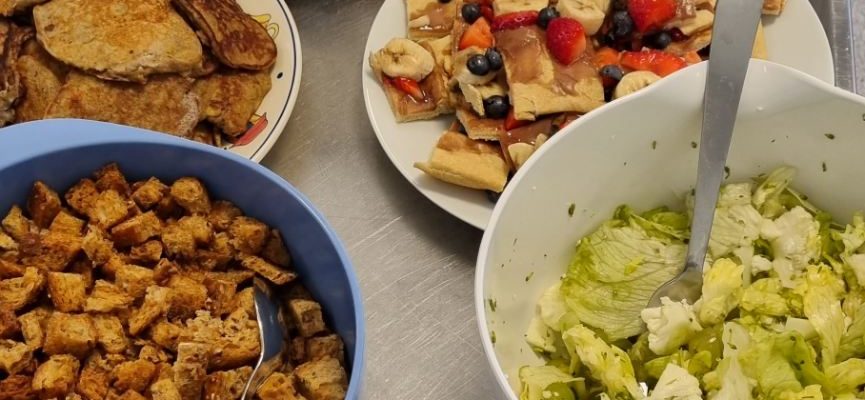Reflection from Norway – Year 7: Food Waste Days 1, 2 and 3
International Day 1
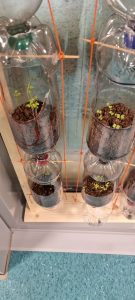 After our meeting in Denmark we were really eager to start our “Food Waste” project. The pupils started preparing by participating in the National Food Waste-Day in Norway. Here we learned a lot about the climate challenge that food waste brings and also what we can make with food that is supposed to be out of date. The students also had homework where they had to fill in a form on how much (and what kind) of food they throw away in a week. They were set the challenge to make dinners with what they already had at home.
After our meeting in Denmark we were really eager to start our “Food Waste” project. The pupils started preparing by participating in the National Food Waste-Day in Norway. Here we learned a lot about the climate challenge that food waste brings and also what we can make with food that is supposed to be out of date. The students also had homework where they had to fill in a form on how much (and what kind) of food they throw away in a week. They were set the challenge to make dinners with what they already had at home.
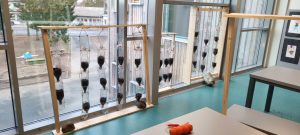 On our first International Day with England, we built our ‘vertical gardens’. We divided the students in two groups so one group built the vertical garden while the other group researched food waste in Norway and England. We planted basil, coriander, chives and other herbs in our bottles. We also had the roots of leeks that we had had to put in water before planting them again. The pupils where very engaged in the tasks and especially liked the meeting we had with the pupils in England. Some of the Norwegian pupils had prepared some facts about the school, the community and their free-time activities. When the pupils could ask each other questions, the conversation was mostly about football and what team they followed, which was very bonding.
On our first International Day with England, we built our ‘vertical gardens’. We divided the students in two groups so one group built the vertical garden while the other group researched food waste in Norway and England. We planted basil, coriander, chives and other herbs in our bottles. We also had the roots of leeks that we had had to put in water before planting them again. The pupils where very engaged in the tasks and especially liked the meeting we had with the pupils in England. Some of the Norwegian pupils had prepared some facts about the school, the community and their free-time activities. When the pupils could ask each other questions, the conversation was mostly about football and what team they followed, which was very bonding.
International Day 2
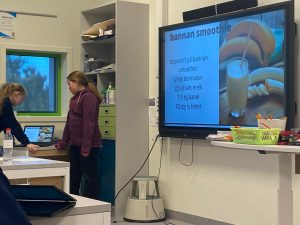 Between the International Day 1 and 2, we had another Covid lookdown in both countries, which meant that we had to postpone Day 2. Because of the long time between the days, Christmas break, wintertime with little sunlight and some construction errors in the vertical gardens, our plants unfortunately died in the middle of January.
Between the International Day 1 and 2, we had another Covid lookdown in both countries, which meant that we had to postpone Day 2. Because of the long time between the days, Christmas break, wintertime with little sunlight and some construction errors in the vertical gardens, our plants unfortunately died in the middle of January.
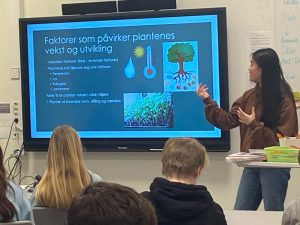 The pupils did a lot of food waste research during the entire year and found out, for example, that in Norway alone we throw away on average 60, 000 bananas every day. We also throw away a lot of carrots, potatoes, eggs and milk. On our second International Day, the pupils made recipes using these products (banana bread, banana pancakes, stews etc.). We then showed what we had made with England. The teacher students also made a presentation about plant cells and the plant life cycle, and we used the ‘Quiver’ app to make it more interactive for the pupils.
The pupils did a lot of food waste research during the entire year and found out, for example, that in Norway alone we throw away on average 60, 000 bananas every day. We also throw away a lot of carrots, potatoes, eggs and milk. On our second International Day, the pupils made recipes using these products (banana bread, banana pancakes, stews etc.). We then showed what we had made with England. The teacher students also made a presentation about plant cells and the plant life cycle, and we used the ‘Quiver’ app to make it more interactive for the pupils.
International Day 3
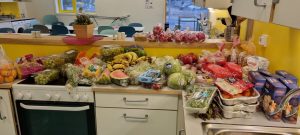 For International Day 3, we were supposed to cook the recipes England made for us. However, we quickly found a problem; we didn’t know what food we would get from the local supermarket. On the morning of the International Day 3, we collected four big boxes
For International Day 3, we were supposed to cook the recipes England made for us. However, we quickly found a problem; we didn’t know what food we would get from the local supermarket. On the morning of the International Day 3, we collected four big boxes  of food from the supermarket. We got a lot of different fruits and vegetables, but also some chicken, meatballs with tomato sauce, bread and cheese. We also bought some basic groceries like milk, flour and eggs. Since what we got from the supermarket didn’t match the recipes from England we had to improvise what we could make. The pupils took charge and came up with fantastic ideas on what they could make.
of food from the supermarket. We got a lot of different fruits and vegetables, but also some chicken, meatballs with tomato sauce, bread and cheese. We also bought some basic groceries like milk, flour and eggs. Since what we got from the supermarket didn’t match the recipes from England we had to improvise what we could make. The pupils took charge and came up with fantastic ideas on what they could make.
We made:
- Fruit salad with grapes, watermelon, bananas and oranges
- Banana pancakes
- Croutons with salt, pepper and chili flakes
- Salad with lettuce, cauliflower, grapes and broccoli
- Salad with lettuce, paprika, tomatoes, cauliflower rice and pine core.
- Grilled chicken
- Dessert pizza with homemade chocolate sauce, strawberries, blueberries and bananas.
- Banana bread
- Grilled asparagus and grilled pimento
- Potato wedges and potato chips
- Waffles with chocolate
- Pizzas with homemade tomato sauce (the pupils used the tomato sauce we got with the meatballs), mozzarella cheese, grilled chicken, meatballs, mushrooms, and tomatoes.
We then ate lunch while we talked online to England. The students really enjoyed the meal and some of them said they never had a better meal. Almost everything was eaten and the leftovers was given to another class and the teachers at school. When we reflected over the fact that all this food was supposed to be thrown away, it was a big eye-opener for most of the pupils; many of them said they would think more about not throwing away food.

